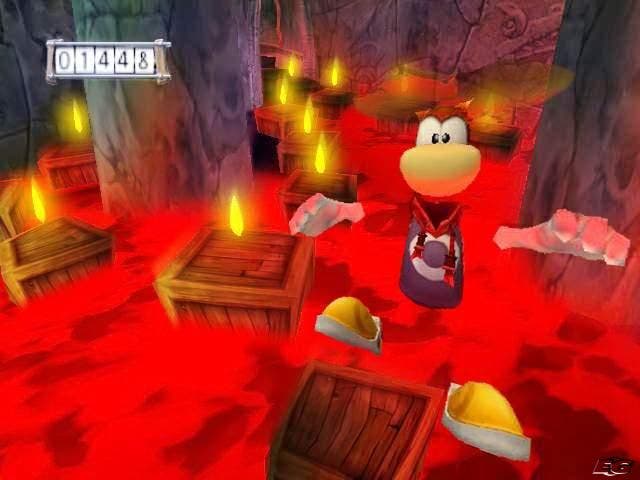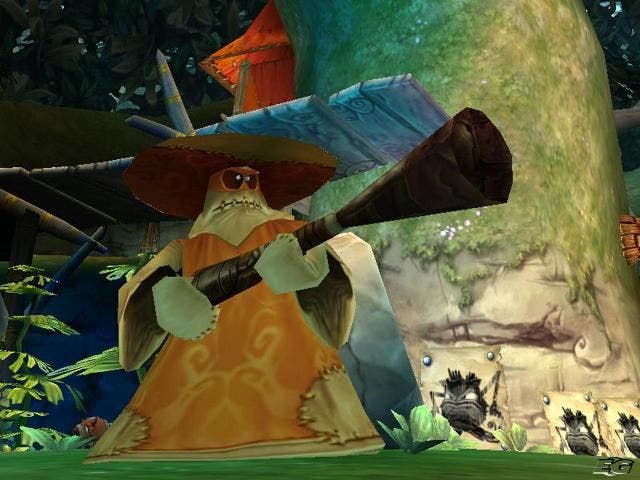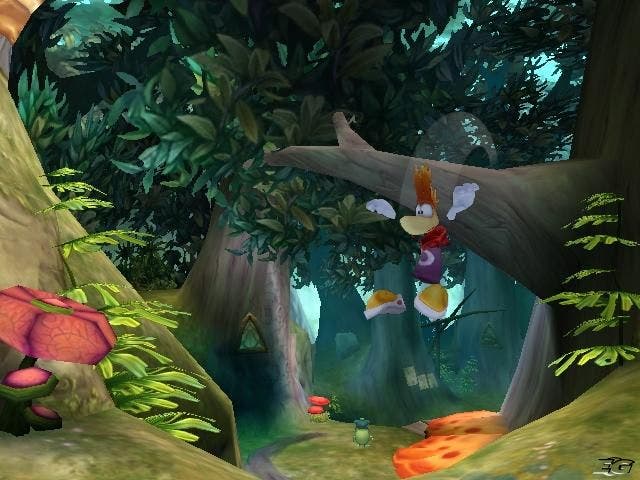Rayman 3: Hoodlum Havoc
Tom was originally going to review it, but then it turned out to be good so Kristan stole it
There are some things in life you just have to accept; there's really very little point questioning them. Arguably, in a gaming sense, the riddle of why Rayman has no limbs must come high up on that list, as well as how on earth did this critically murdered franchise end up becoming the UK's biggest selling platformer? You think we're making it up don't you? Released at the same time as the launch of the PlayStation back in September 1995, the game is still selling around 2,000 copies a week, and has shifted around 1.5 million* copies in the UK alone. That's more than any Mario, Crash, or Sonic game has ever registered on the ChartTrack panel. The follow up hasn't fared quite so well commercially, but as with the original, once its price came down, the sales ramped up. Suffice to say, this is also selling about 2,000 copies a week at a knockdown price.
So the Rayman games are for kids then? And they're French? So why do we care about the third (fourth if you count the filler release Rayman M)? If the truth be known, it's down to the likes of Naughty Dog and Insomniac for restoring our faith in the genre with classics like Jak & Daxter and Ratchet & Clank. The fact is, we're really enjoying jumping around, collecting everything in sight at the moment, and even limbless French platformers have snared our attention. What's that all about?
* Estimated combined sales of PSX, PC, GBC and GBA as of end of Jan 2003, based on ChartTrack data.

Boys in the Hood
The storyline's fairly tenuous, as they tend to be with jump and collect games, but we'll give you a quick run through in case you're interested. Basically a 'depraved and hysterical' evil red Lum by the name of Andre wants to conquer the world, and has somehow turned his fellow red Lums into black Lums, which steal animal's hair in order to weave costumes for themselves. Dressed in big long coats, hooded and armed with guns, the army of 'Hoodlums' (geddit) have captured all the Teensies, and it's Rayman's job to liberate them and sort out these pesky Hoods. To make matters even quirkier, Rayman's long time buddy Globox has somehow managed to swallow Andre, and develops an unquenchable thirst for Plum juice - meaning Rayman not only has to defeat all manner of foe, but seek out three Teensie doctors to cure his pal. No one ever said it would be straightforward.
Fortunately, our limbless friend is able to harness the Hoodlum's five superpowers for a limited time, giving Rayman enhanced abilities including Vortex (make enemies spin), Heavy Metal Fist (heavy punch), Lock Jaw (swing between metal handles), Shock Rocket (guided missile), and Throttle Copter (to reach higher ledges, etc). The experienced platformers among you will immediately note plenty of inspiration from the aforementioned Jak & Daxter, as well as the recently released Ratchet & Clank. Just about every one of Rayman's superpowers feature in the latter at some stage, with the major difference being the temporary nature of his powers - which is the exact mechanic employed in the former. Talent borrows, genius steals?
Obviously as a cutesy third person platformer you don't come around these parts expecting innovation and it's hard to find a tremendous amount in the core of Rayman 3. As you'd expect from a game such as this, your experiences will roughly follow this well trodden path: wander around, collect jewels, shoot enemies, collect temporary power up, reach previously unattainable part of the level, free the Teensie from their cage, repeat until boss encounter.

Nice mechanic, bonkers camera
One element that is quite a novel progression is the combat mechanic, which gives you the ability to curve your (already detached) fist around corners, giving you the opportunity to knock out enemies even if they're hiding behind a pillar. Holding down the right trigger allows Rayman to lock on to the target, which allows you to not only strafe left and right and avoid their projectiles, but it keeps the target in sight while you're moving around. This all sounds very useful in principle, and in practise it might, were it not for the complete inability of the camera to behave itself, or for the lock on to work effectively. As with so many third person action games, if the camera's broken, you're in a whole heap of trouble, and Rayman 3's potty cameraman gets you in a mess time and time again. For example, you're normally faced with around three or four Hoodlums, and in order to lock onto them, you've got to be pretty close. If you can lock on immediately, then it's quite straightforward to dispatch almost anything without too much hassle, but the game's inherent, overriding flaw is that the camera is so erratic that even it rarely considers your combat requirements.
You can, if you like, attempt to wrestle control back from the CPU and use the right stick to steer the camera back to a position of your choosing. Except that the drunken cameraman really doesn't take too kindly to your insolence, and has a tendency to swing wildly away from your foe at the most inconvenient time, while enemy bombardment rains down on your blind side. If you could lock on from a further distance, and cycle between targets then this kind of thing wouldn't be an issue, but you'll be regularly tormented by it, especially once the enemies get smarter, harder and more evil. It really does let down what is a fundamental part of the game, and after such a long time in the making, you'd think that they'd at least get that bit right. Another gaffe is the lack of a persistent state once you clear a level. Annoyingly, unlike most games in this genre, all items and monsters return should you decide to go back and replay a world, making the task of clearing levels rather more taxing than it should be.

Jaw dropping
In its favour, Rayman 3 does excel in many other fundamental areas. Top of the pile is its immensely impressive graphics engine, which at times is jaw dropping. Set across five worlds, the usual clichés are present and correct (lava, snow, caves, forest, swamp), but it hardly matters when it looks this good. The reflective surfaces and detail packed levels add a jaw dropping sheen to everything, and go towards creating environments that you actually enjoy exploring. Despite there only being five worlds, the variety within them is often pleasingly broad - for example midway through the game you get to ascend, (and then descend) through a crystal tower, which is this reviewer's opinion is one of the most stunning settings ever seen in a videogame. The characters are also laden with detail and incidental touches, and create a cartoon world feel. It's this undoubted quality that drives you through, and helps you come to terms with the derivative gameplay and combat issues.
The general quality of the script and voice acting has moved into a different league too, and the game feels far less like the kiddies platform game of old, and much more in line with the Disney-esque adult humour seen in the best platformers of late. Globox's delirious antics as he glugs on yet another barrel of plum juice, or stands around talking to birds give the game a great deal of warmth, and this buddy dynamic helps Rayman's appeal extend far further. The between level sections are, however, rather bolted on and seem to have no real connection to the main game. The basic principle sees Rayman hopping between fast approaching white lines in a psychedelic environment. It's all rather abstract, but seems to be an excuse to play funky tunes for a few minutes, and dazzle the player with some whacked out visuals. It's all very trial and error, and is about as far as the game goes towards offering a break from the main dish.

How to torture the limbless wonder
Elsewhere, Rayman 3 offers a myriad of extras that are worthy of note. Rather than dish out pointless concept sketches and new costumes as so many games do, collecting the various items that are scattered around rewards you with points, which in turn unlock a stack of bonus mini games once you reach preset point limits. In addition, amusing videos unlock, showing Rayman being tortured in increasingly brutal ways. Admit it, you would, wouldn't you? And if that wasn't enough, there are also a number of GBA link-up games, which we will tell you all about in the near future in a separate review.
There plenty to admire about Rayman 3, and for the franchise's millions of fans, it's going to satisfy their needs for limbless platforming antics. For the platforming connoisseur, you're going to be reasonably happy with it; it's pretty, it's quite a challenge, and is loaded with rewards. But you'll quickly come to the conclusion that for all its charms, it doesn't offer enough new ideas, and that its competition is just too strong. Still, for us to enjoy a Rayman game, that's a revelation in itself.
Rayman 3: Hoodlum Havoc screenshots (Cube)
Rayman 3: Hoodlum Havoc screenshots (GBA)
Rayman 3: Hoodlum Havoc screenshots (PS2)
Rayman 3: Hoodlum Havoc screenshots (PC)

